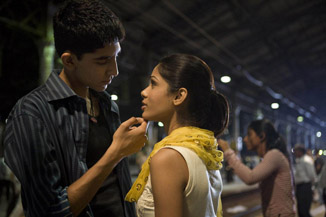What Went Right: Slumdog Millionaire
By Shalimar Shahota
December 2, 2013
“You wanted to see a bit of real India,” says Jamal to two American tourists after their car has been broken into. “Here it is.” This is probably one of the factors behind why Slumdog Millionaire was a success, in that what’s portrayed in Danny Boyle’s film is certainly not the tourist brochure version of India that is often depicted in Bollywood blockbusters. So much so that the term “poverty porn” was coined - that the film sensationalises the stereotypical view of poverty in India, so as to provoke a more extreme reaction amongst audiences. Yet the film comes across as a strange docu-fairy-tale hybrid and was not the kind of thing that most audiences of mainstream cinema were used to seeing – a reality that’s soaked in ras malai.
Eighteen-year-old Jamal Malik (Dev Patel) from Mumbai has miraculously managed to make his way as a contestant on India’s Who Wants to Be a Millionaire? He’s just one question away from winning the top prize, but before he can answer it the show runs out of time… and Jamal is suddenly arrested by the police. He is suspected of cheating, because, “What can a slumdog possibly know?” Jamal then tells the police the story of his life up to this point, how he, his brother Salim and fellow street child Latika made it from the slums, and how certain moments led to Jamal knowing the answers.
Slumdog Millionaire is essentially a rags to riches story, a modern day fairy tale, the modern part being that Jamal accumulates his riches by taking part in a game show. Being a fairy tale means that the audience has to accept (or at least go along with) a few impossible scenarios.
Slumdog Millionaire was backed by Celador (the UK production company behind the original Who Wants to Be a Millionaire? TV series), Film4 and Pathé. Tessa Ross of Film4 (the film’s executive producer) optioned the film rights in Vikas Swarup’s novel Q&A, approaching Simon Beaufoy to pen the script. Director Danny Boyle read it and knew within the first 20 pages that he was going to direct it. The film had a production budget of $15 million, with Warner Independent Pictures agreeing to distribute it in the US.
During shooting, Loveleen Tandan was initially involved as a casting director, but eventually became credited as a co-director. It was she who suggested that parts of the film had to be in Hindi rather than completely in English. It was a move that also helped draw in a wider Indian audience.
In May 2008, the film was in post-production when Boyle was given the news that Warner Independent Pictures would be closing. “Warners weren’t going to distribute it because they closed Warner Independent,” said Boyle to Empire magazine. “We didn’t have a North American distributor.” The film was set up at Warner Bros., who suggested releasing the film straight-to-DVD. They then told Boyle that alternatively he could pick another distributor to sell the film to. In stepped Fox Searchlight, who originally expressed interest, and agreed to market and distribute the film in the US. Said Fox Searchlight President Peter Rice, “The film is tour de force of filmmaking that hits you both viscerally and emotionally at every twist and turn. Everyone here was just astonished by the movie and immediately knew we had to be involved with it. Searchlight is pleased to able to work with Warner Bros. on such a unique and extraordinary film.”
Continued:
1
2
3




